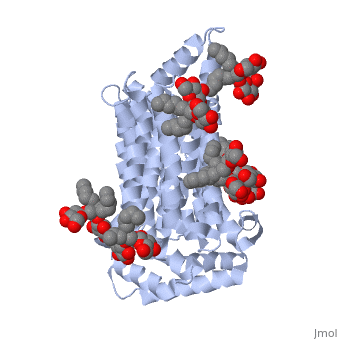Sandbox Reserved 1319
From Proteopedia
Contents |
GLUT3: Glucose Transporter in Mammalian Cells
|
Function
GLUT3 is a facilitated glucose transporter that is encoded for by the gene SLC2A3. It serves highly metabolic and oxidative systems as it has a high affinity for glucose and a significant capacity for transport in comparison to GLUT1, GLUT2, GLUT3, and GLUT4. It is the glucose transporter for neurons and is also known as the neuronal glucose transporter. It plays a key role in metabolism in the brain. While GLUT3 can be found in the cell body of the neuron, it is mostly found in the axons and dendrites. GLUT3 also acts as the glucose transporter for cells such as sperm, white blood cells, and embryonic cells.
Structure
The structure of this protein contains that are composed of two separate chains (alpha helix shown in blue). The structure of GLUT3 also consists of ligands and and is composed of 481 amino acids. It has four different transmembrane segments that are repeated three times (for a total of 12 transmembrane segments).
Discovery
GLUT3 was the third glucose transporter to be discovered after GLUT1 and GLUT2. It was first cloned in 1988 by using a fetal skeletal muscle cell. It is part of the glucose transporter family, which is present in all phyla since glucose is a primary source of energy.
Diseases
Type 2 Diabetes: Higher glucose concentration affects GLUT expression in white blood cells. The level of transcripts encoding GLUT3 are reduced in diabetic patients, which could impair the immune system and make patients more susceptible to infection.
Alzheimer's Disease: Decreased levels of GLUT3 in the brain of Alzheimer's patients leads to hyperphosphorylation of the Tau protein, which can lead to tangles.
Huntington's Disease: Leads to decreased expression of GLUT3. Huntington's impairs the function of Rab11, which regulates GLUT3 in the brain.

